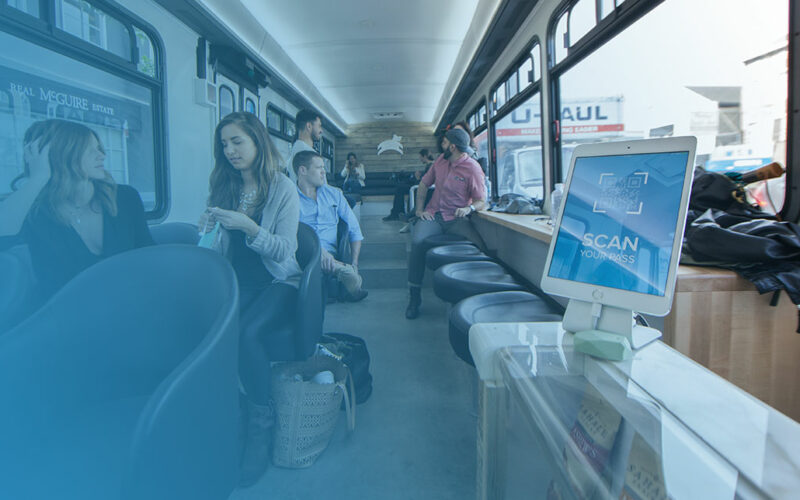Transit’s Lost Leap: What Happened to Leap Transit?

In a city where the fog is as iconic as the Golden Gate, San Francisco’s Leap Transit emerged with a splash, reimagining the daily grind into Silicon Valley’s luxury-lined commute.
Yet, what most don’t know is the intricate web of events that led to the transit service’s abrupt disappearance.
This tale isn’t just about buses and routes; it’s a journey through ambition, regulations, and the shifting sands of urban transportation.
Whether you’re a daily rider turned pedestrian, an intrigued urban commuter, or simply captivated by the rise and fall of tech startups, the unraveling story of Leap Transit holds valuable insights.
By the close, expect to not just grasp what happened to Leap Transit but to delve deep into the challenges mobility service providers face amidst transportation network companies and stringent bus regulation laws.
We’ll navigate through the labyrinth of venture capitalists, public trust, and the quest for sustainable urban transport.
The Vision and Inception of Leap Transit
Founding and Mission
So, who came up with this brainwave? Well, there was this entrepreneur with stars in his eyes, dreaming of revolutionizing how we hit the road in the city.
He wasn’t just about the glitz, though. He saw a gap and went for it, getting the ball rolling with some serious backing from folks with deep pockets. They all believed they could make a splash.
Unique Selling Proposition
Amenities Offered by Leap Transit

Okay, so here’s where it gets juicy. We’re talking buses with Wi-Fi that doesn’t make you want to pull your hair out, USB ports galore, and even a snack bar.
It’s like they crammed a coffee shop on wheels!
Target Demographic and Pricing
Now, who were they trying to woo with all this swankiness? Well, not your average Joe, that’s for sure.
They had their eyes on the suits and the trendsetters, folks who wouldn’t blink at a pricier tag for a comfier ride.
They weren’t playing the regular bus game – they were in it to win it with a touch of class.
Operational Challenges and Regulatory Hurdles
Compliance Issues
Alright, let’s dive into the nitty-gritty. Everyone’s wondering, “what happened to Leap Transit?” Well, it’s a bit of a mess, really.
They started with a bang, but then, they hit some serious bumps. You see, Leap Transit was trying to be the cool new kid on the block, but they kinda played hooky with some rules.
Non-compliance with San Francisco Regulations
San Francisco has a bunch of rules for public transport, and Leap Transit? They sort of… glossed over them.
We’re talking safety stuff, wheelchair access – the basics, you know? And man, did that stir up a storm.
Accessibility Concerns and Legal Challenges
People were not happy. Accessibility is a big deal, and Leap was slacking.
It wasn’t long before the legal eagles swooped in, and let’s just say, they weren’t bringing good news. Leap Transit was in hot water, and everyone was watching.
Permit and Licensing Complications
Operating without Necessary Permits
But wait, there’s more. Permits. You need them to run buses in the city. Guess who was missing a few?
Yep, our friends at Leap Transit. It’s like throwing a party but forgetting to invite the host.
Conflicts with City and State Regulations
The city was not having it. When you mess with city and state regs, you’re poking a bear. And this bear bit back, hard.
Leap Transit was learning the hard way that you can’t just leap over the rules.
Financial Struggles and Bankruptcy
Funding and Financial Performance
So, where was the money in all this?
Total Funding Amount and Key Investors
Leap Transit had some big names tossing coins into the hat. We’re talking millions, my friend. But money can’t buy happiness, or in this case, stability.
Revenue versus Operational Costs
Turns out, fancy buses cost a fancy penny to run.
Who knew, right? And with the legal headaches and all, the math just wasn’t adding up.
Bankruptcy Proceedings
Debt and Asset Range at the Time of Bankruptcy
So, they hit a wall. The cash ran dry, debts piled up, and it was time to face the music. Bankruptcy was knocking on the door, and Leap Transit had to let it in.
Auction and Sale of Remaining Assets
And then came the auction. Everything must go! Buses, gadgets – you name it. It was like the world’s saddest yard sale. And just like that, the Leap Transit dream was on the clearance rack.
Public Perception and Market Response
Criticism and Controversy
So, we’ve chatted about the whole what happened to Leap Transit drama. But what did the people think? Well, let’s just say it was a mixed bag.
Perception as a Service for the Affluent
Some folks saw Leap Transit as this swanky, velvet-rope kind of deal. It was like the VIP section in a club, but for buses. Not everyone was down for that. It kinda rubbed some people the wrong way, you know?
Impact on the Public Transit System and Local Community
Then there’s the local scene. Leap Transit was strutting its stuff, but did it play nice with the regular buses and the people who relied on them? Not so much. It was like that new kid who doesn’t want to share the sandbox.
Customer Experience
Initial Success and User Feedback
But hey, it wasn’t all side-eyes and shade. In the beginning, Leap Transit had folks lining up. People were digging the comfy seats and the fancy coffee. It was all the rage.
Decline in Usage and Customer Base
But as they say, what goes up must come down. The buzz died down, the shiny wore off, and people started to bail. Those cushy buses started feeling pretty lonely.
FAQ On What Happened To Leap Transit
Why Did Leap Transit Stop Operating?
Leap Transit faced a tangle of operational hurdles and regulatory compliance issues. Think of a ballet on an obstacle course — ambitious choreography meeting tough ground reality.
They briefly stopped to sort the legalities with the California Public Utilities Commission, but ultimately, the dance ended; the service didn’t resume.
What Was Leap Transit?
Leap was a concept that sparkled in the eyes of the urbane commuter. Private city transport, reclad. With its plush seats and artisan coffee, Leap chose to transcend typical public transit alternatives. A bus service less mundane, promising more than just A to B.
Was Leap Transit Economically Viable?
Leap’s economic path was strewn with questions. Charging a premium, it was sustainable theoretically. However, operational costs and limited scalability questioned its long-term survival in a market where price and practicality jostle daily.
Who Funded Leap Transit?
Venture capitalists who shared a vision of transportation as a service (TaaS) lined Leap’s coffers. These enthusiasts, often Silicon Valley patrons, infused cash, betting on a future where ride-sharing competitors wouldn’t just vie for market share, but redefine the experience.
What Were Leap Transit’s Main Challenges?
Regulations and market penetration were the twin Goliaths. Just as David, Leap came armed, not with a sling, but with mobility service innovations. Still, navigating bus regulation laws while carving a niche in a traffic congestion-plagued arena was a challenge too demanding.
How Did Users React to Leap Transit’s Shutdown?
The response varied from chagrin to introspection. Urbanites cherished the Leap affair, while others pondered the audacity of such an overhauled commuter bus system. It left a void, and a question — was this a glimpse into the future of urban transportation or a luxury-laden misstep?
What Impact Did Leap Transit Have on the Transport Industry?
Consider Leap a catalyst in a sleepy industry. Stirring conversations about passenger experience and efficiency, it nudged norms. A luxury commute, yes, but also a portrayal of what shifts in urban transit models might materialize if imagination steered policy.
Could Leap Transit Have Been Saved?
Perhaps, with a lifebuoy of regulatory leniency and a dash of operational refinement. Catering to the broader urban commuter base might’ve buoyed its hopes. But sailing against stiff public transit regulations and entrenched competition was a stormy affair.
Has There Been Anything Like Leap Transit Since?
Imitation is the boldest flattery. Post Leap, the dust settled, then rose anew with others inching forward, cautious yet eager to innovate. Each aspiring to the Leap legacy, to shift public transportation norms without falling into the same pitfalls.
What Lessons Can Entrepreneurs Learn From Leap Transit?
That balance is key — between grandeur and ground, between innovation in public transportation and operational pragmatism.
Leap is a study in daring far, maybe a tad too far, and the fine print that dances between the lines of regulation and revolution in the transportation network stage.
Conclusion
As the curtain falls on the story of what happened to Leap Transit, let’s not view its journey with mere passivity. In its ambition, a model is etched for traversing the intricate nexus of urban transportation, where innovation, regulatory frameworks, and market forces collide.
- Luxe buses sailed the streets — turned heads, sparked chatter.
- The plot thickened, with venture capitalists and commuters watching.
- A pivot, some say, could’ve steered this undertaking clear of demise.
Yet amid the detours, Leap Transit mirrors a Silicon Valley archetype: daring, disruptive, wrought with potential, albeit marred by backstage complexities. It stands as a parable for entrepreneurs, infusing the transportation industry with ideas that perhaps were ahead of their time, or simply mismatched to the environment provided.
Let’s carry forward not only an echo of Leap’s aspirations but a keener perception of that delicate balance: creativity entwined with pragmatism, the customer’s desires in arm’s reach of efficiency.








